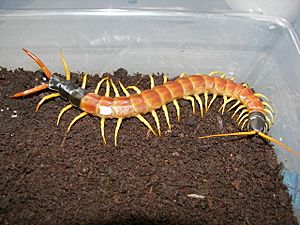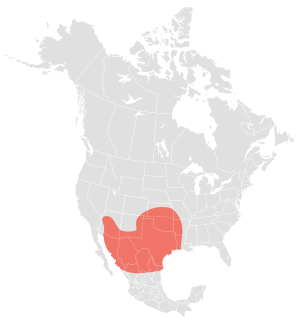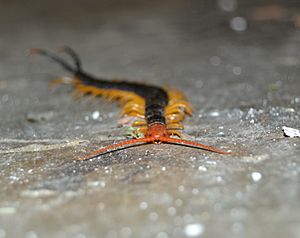Arizona desert centipede facts for kids
Quick facts for kids Arizona desert centipede |
|
|---|---|
 |
|
| Scientific classification | |
 |
|
| Approximate distribution of S. heros | |
| Synonyms | |
|
The Scolopendra heros, often called the giant desert centipede or Texas redheaded centipede, is a very large centipede. You can find it in the Southwestern United States and Northern Mexico. It's one of the biggest centipedes in North America.
Contents
About the Giant Redheaded Centipede
The Scolopendra heros is the largest centipede in North America. It usually grows to about 6.5 inches long. Some can even reach over 8 inches in the wild. This centipede has 21 or 23 pairs of legs on its body.
These centipedes have bright colors that warn other animals. This is called warning coloration. It tells predators to stay away. There are different color types of this centipede. One type, called castaneiceps, lives in places like Texas and Arkansas. It has a bright red head and a greenish-black body and tail. This is why it's often called the "giant redheaded centipede."
Where They Live
S. heros lives in northern Mexico and the southwestern United States. You can find them from New Mexico and Arizona in the west. They also live in Arkansas, Missouri, and Louisiana in the east.
Even though they are called "giant desert centipedes," they don't just live in deserts. They also live in rocky woodland areas. For example, they are found in the forests of Arkansas. On hot days, these centipedes stay underground. They come out when the weather is cloudy and cooler.
How They Hunt and What They Eat
The S. heros is a nocturnal hunter. This means it hunts mostly at night. It eats other small animals. These include insects, spiders, small rodents, reptiles, and amphibians.
This centipede is very quick. It can even jump into the air to catch flying insects. It uses its venom to make its prey unable to move. This makes it easier for the centipede to eat its meal.
Life Cycle of a Centipede
S. heros centipedes hatch from eggs. Young centipedes are called nymphs. As they grow, they shed their outer skin, called an exoskeleton. This process is called molting. Each time they molt, they enter a new stage of life called an instar.
During these growth stages, they often grow more legs. They might start with about 10 legs. After molting several times, they can have 18 or more. These centipedes can live for up to 5 years or even longer. How long they live depends on their environment.
About Their Venom
The venom of S. heros is strong. It contains different substances that affect animals. Some parts of the venom can harm cells. Other parts target the nervous system of insects. This makes insects unable to move or feel things. For larger animals, the venom can affect their body systems. This makes them easier for the centipede to catch.
A bite from an S. heros centipede is very painful for humans. It usually causes a sharp, burning pain and swelling where it bites. While it's very uncomfortable, a bite from this centipede has never caused a confirmed death in humans. Sometimes, people might feel sick, get a headache, or have a small skin injury. However, these serious effects are rare.


